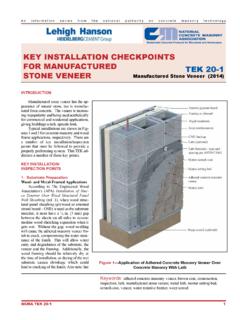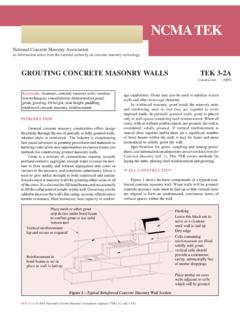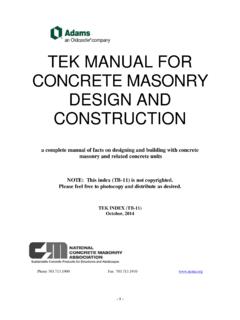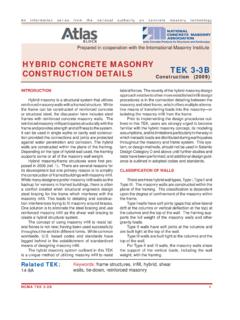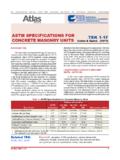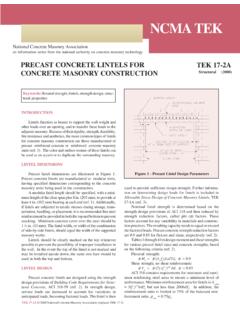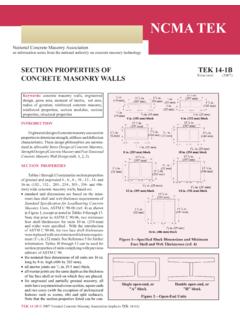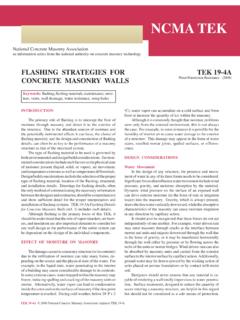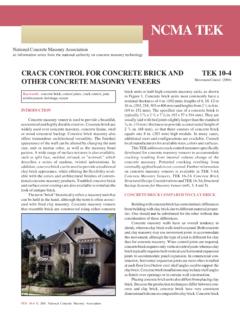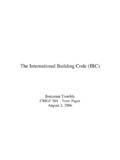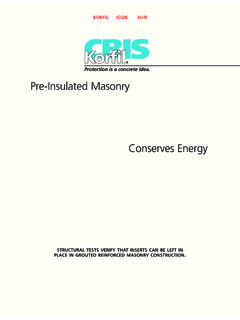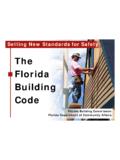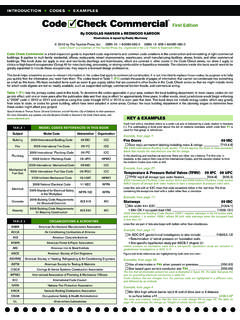Transcription of ENERGY CODE COMPLIANCE TEK 6-4B USING ... - …
1 NCMA TEK 6-4B 1An information series from the national authority on concrete masonry technologyENERGY code COMPLIANCE USING COMCHECKTMTEK 6-4 BEnergy & IAQ (2012)INTRODUCTION COMcheckTM (ref. 1) is software developed by the Department of ENERGY specifically for demonstrat-ing COMPLIANCE with nationally recognized ENERGY codes. Versions are available for download (for various software platforms) as well as for online use. USING the tradeoff COMPLIANCE method allowed by ENERGY codes, such as COMcheck software, may provide more design flexibility when compared to prescriptive table requirements. For example, parameters such as fenestration area can be increased above the prescriptive limitations, and the ad-ditional ENERGY demand offset by adjusting fenestration characteristics and/or increasing roof or wall insulation levels. In addition, once the basic building description has been entered into the program and saved, design changes and/or the building location can be quickly modified, and COMPLIANCE immediately redetermined.
2 COMcheck has another advantage in that various national and state ENERGY codes and ENERGY standards are included within the program, making it easy for designers who work in several states to be able to use the same COMPLIANCE tool for many different project locations. After the building data is entered, COMcheck indicates the percentage by which the proposed building envelope passes or fails the chosen ENERGY code requirements. The program can be downloaded free of charge from: It is ad-visable to also review the known problems in COMcheck, which are documented on this same site. This TEK provides a basic overview of the program as well as some guidance on concrete masonry building envelope COMPLIANCE . applICabIlITy COMcheck enables the user to choose the code and year for COMPLIANCE . This is a critical first step, as ENERGY code requirements can be significantly different from one edition of the code to the next. If unknown, the local build-ing department can provide this information.
3 Currently, the following codes are included: the International ENERGY Conservation code (ref. 2), IECC (2000, 2001, 2003, 2004, 2006 and 2009 editions), ASHRAE Standard , ENERGY Standard for Buildings Except Low-Rise Residential Buildings (ref. 3) (2001 2004, 2007 and 2010 editions), and state ENERGY codes for New York, North Carolina, Oregon and Vermont, as well as for Puerto Rico. COMcheck is applicable to all buildings other than low-rise residential, , most commercial, industrial, hotels and educational buildings as well as residential buildings over three stories in height. For low-rise residential buildings, the program REScheckTM (ref. 4) can be downloaded from eNvelOpe COMPLIANCE After choosing the appropriate code , the Project screen is used to enter the building location (which determines climate) and the building use category, such as school, of-fice or restaurant (which determines the internal heat loads, such as lighting loads).
4 The building's gross floor area is also entered on the Project screen. Note that for multi-story buildings, the total area of all floors is entered, while for single story buildings, the gross floor area is generally equal to roof area. The user can also add descriptive text about the building, client and location. After the basic information has been entered, the user Related TEK:6-1B, 6-2B, 6-5A, 6-11A, 6-16 AKeywords: building envelope, code COMPLIANCE , COMcheck, ENERGY codes, ENERGY efficiency, softwareit be in the roof insulation, high-performance glazing or wall performance, based on the economics of the products involved and on other project goals or restrictions. above-grade Concrete masonry Walls Figure 1 shows the above-grade concrete masonry wall options within COMcheck that can be used to dem-onstrate COMPLIANCE with the 2009 IECC. Note that the specific walls listed may vary somewhat with the code chosen for COMPLIANCE .
5 COMcheck contains a database of precalculated thermal properties for various systems. As a result, once the user chooses a concrete block wall construction, the program applies an associated R-value and, for masonry walls, a heat storage capacity describing the wall's thermal mass. Figure 1 shows that COMcheck includes various single wythe concrete masonry walls, with or without insulation in the ungrouted cells, as follows: Concrete Block, Solid Grouted applies to fully grouted masonry walls. The R-value of any insulation installed between furring should be entered under the Cavity Insulation R-Value column, while the R-value of continu-ous insulation should be entered under the Continuous Insulation R-Value column. Concrete Block, Partially Grouted, Cells Empty applies to masonry with at least 50% of the masonry cells free of grout or cells that are grouted no more than 32 in. chooses the Envelope tab to display the envelope compli-ance screen (see Figure 1).
6 Building envelope data input for COMcheck is straightforward. The user describes the building envelope, component by component, either from a series of drop-down menus or from user-entered data. Individual envelope elements (roof, skylight, exterior wall, etc.) are chosen from the row above the data table. Then, the table is populated with a description of each ele-ment: the element size, R-values or U-factors to describe the steady-state resistance to heat transfer, and solar heat gain coefficient (SHGC) for windows. When the building envelope has been completely described, the software combines this input with the weather data embedded in the program to perform a location-specific analysis. The output is a pass/fail rating (in the lower left-hand corner of the screen), along with an indication of how close the proposed building is to meeting the specified code requirements. In Figure 1, the proposed building exceeds the minimum code requirements by 1%.
7 This percentage can help the designer understand the building envelope's sensitivity to various design changes and help optimize building components. If the program returns Fails, one or more envelope parameters can be quickly modified and COMPLIANCE im-mediately redetermined. Thus, the user can choose from various ways to improve the envelope performance, whether Figure 1 COmcheck building envelope COMPLIANCE Screen Showing Drop-Down menu for above grade Concrete masonry Walls2 NCMA TEK 6-4B(813 mm) vertically and 48 in. (1,219 mm) hori-zontally, and with no insulation in the ungrouted cells. Similar to solid masonry , the R-value of any insulation installed between furring should be entered under the Cavity Insulation R-Value column, while the R-value of continuous insulation should be entered under the Continuous Insulation R-Value column. Concrete Block, Partially Grouted, Cells Insulated applies to masonry with at least 50% of the masonry cells free of grout (see Table 1) or cells that are grouted no more than 32 in.
8 (813 mm) vertically and 48 in. (1,219 mm) horizontally, and with insulation in the ungrouted cells. masonry core insulation is typically molded polystyrene inserts, expanded perlite or ver-miculite granular fills or foams (see Insulating Concrete masonry Walls, TEK 6-11A (ref. 5), for more informa-tion on insulating concrete masonry walls). Although the R-value of this cell insulation is already accounted for in the program and need not be entered by the user, note that the U-factor included in COMcheck for cell-insulated concrete masonry is conservative. Often, the actual wall U-factor will be lower ( , R-value will be higher) than that reflected in the program. In these cases, the user can enter their own wall performance data (see below). Additional insulation installed on the interior or exterior side of the masonry , such as EIFS or insulation between furring, should be entered separately in the Continuous Insulation R-Value or Cavity Insula-tion R-Value column, respectively.
9 Concrete Block, Unreinforced, Cells Empty applies to masonry without reinforcement and without insulation in the ungrouted cells. Although by definition these walls do not include reinforcement, up to 50% of the masonry cells are permitted to be grout-filled. Concrete Block, Unreinforced, Cells Insulated applies to masonry without reinforcement and with insulation in the cells. In some cases, the concrete masonry wall being used for the project is significantly different from those listed in the program (see refs. 6 and 7 for R-values of concrete masonry walls). For example, a variety of special unit shapes have been developed to increase ENERGY efficiency. These units often have reduced web areas to reduce heat loss due to thermal bridging through the webs. Even conventional concrete masonry units may have significantly better ther-mal performance than that assumed in COMcheck, because the thermal values in COMcheck for concrete masonry are conservative for many walls.
10 R-values in the COMcheck database for concrete masonry with insulated cells are based on loose fill insulation, which has a relatively low R-value per inch of thickness. In addition, partially grouted walls are assumed to be grouted at 32 in. (813 mm) vertically and 48 in. (1,219 mm) horizontally. Buildings with masonry walls utilizing better-per-NCMA TEK 6-4B 3forming cell insulation systems, special unit shapes and/or less grout can demonstrate COMPLIANCE by USING the Other option from the exterior wall pull-down menu. Note that when the Other and Mass options are chosen, the screen displays a new column for heat capacity (which allows COMcheck to distinguish masonry wall require-ments from frame wall requirements when determining COMPLIANCE ). When custom data is entered USING this op-tion, the user enters both the overall U-factor of the wall (including all insulation and finish materials) as well as the wall heat capacity (see TEK 6-16A , Heat Capacity (HC) Values for Concrete masonry Walls, ref.)
